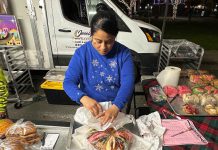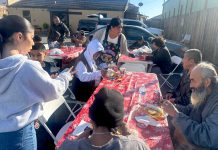
SANTA CRUZ COUNTY—Santa Cruz County Health Officer Gail Newel on Tuesday revised her shelter-in-place order to align most of the county’s restrictions with that of Gov. Gavin Newsom’s stay-at-home order.
The new county order will open places of worship, in-store retail, outdoor museums and limited personal services such as car washes and pet grooming. It goes into effect at 11:59pm tonight.
The order maintains language on daily beach closures between 11am-5pm, as well as language restricting patronage at local hotels, motels and vacations rentals, including asking lodging owners to maintain a log of the purposes customers are staying at local establishments.
State leaders on Monday loosened restrictions on places of worship, allowing them to throw their doors open with approval from their respective county health departments.
Retail, too, got the greenlight statewide to open for in-store shopping, giving businesses that have been devastated by state and county orders a fighting chance.
Newsom on Tuesday also said counties that have met variance requirements and have received approval from the state may allow barber shops and hairdressers to open. Santa Cruz County has met the requirements and is expected to apply for the variance at a special Board of Supervisors meeting set for Friday at 9am. State review may take up to a week, county officials said.
Neighboring Monterey County on Tuesday applied for the variance after its Board of Supervisors voted unanimously to send its attestation application to the state.
“As we move forward with these changes, I want to caution everyone that Covid-19 is still present in our community. Anyone who is 65 years old or older, as well as those who are medically vulnerable, should continue sheltering in place,” Newel said. “I urge all members of our community to help those who need to shelter by continuing to offer help and check in.”
The order can be found at santacruzhealth.org/coronavirus. It will expire July 1.
Local churches, synagogues and temples are now allowed to resume services at 25 percent capacity, or a maximum of 100 people—whichever is fewer. They, however, must meet stringent guidelines provided on Monday by the California Department of Public Health and Cal/OSHA that aim to slow the spread of the novel coronavirus.
The 13-page document calls on places of worship to enforce physical distancing measures, require use of face coverings and train all employees and volunteers on their so-called workplace specific plan, which should include increased disinfecting routines.
It also says visitors should be screened for symptoms of Covid-19 before being allowed in, and that places of worship should strongly consider halting or modifying singing, group performances and other practices such as communion that increase the likelihood of transmission.
Places of worship will be open under the restrictions for 21 days. The interval accounts for seven days for religious communities to prepare and reopen in addition to a 14-day incubation period of Covid-19.
Following those three weeks, the CDPH and county health department will “review and assess the impact of the imposed limits on public health and provide further direction as part of a phased-in restoration of activities in places of worship.”
It is still unclear when churches in the Pajaro Valley and the greater Monterey Bay will open. Bishop Daniel Garcia of the Diocese of Monterey, which represents dozens of local churches, including St. Patrick’s Church and Our Lady Help of Christians in Watsonville and Our Lady of the Assumption in Pajaro, in a recent video announcement said its places of worship would not open until they put together comprehensive plans of how to do so.
“At each parish (we’re) trying to create the logistics of what would it look like when we return,” he said. “Who can come? Where can you sit?
“We do all want to return and go back into those celebrations that we’ve been accustomed to, and that we’ve been missing, but at the same time we want to do it in a very safe way.”
At Twin Lakes Church in Aptos, Pastor René Schlaepfer said Newsom’s announcement regarding loosening up orders for church gatherings “surprised all of us.” He said that TLC has a capacity of 1,500 people, which translates, under the new guidelines, to safely welcoming no more than 100 parishioners.
“We want to be thoughtful and careful and wise,” Schlaepfer said. We don’t know the complete answers. Above all we have to look into this responsibly; these things take time.”
He also raised the question of making sure vulnerable populations—seniors and people with preexisting conditions—are kept safe. TLC also operates a host of other services other than Sunday worship such as 12-step support groups, youth groups, bible studies and recovery programs.
“Do these rules only apply to weekend worship services, or do they include the other programs?” Schlaepfer asked. “And now, how will churches enforce safe distancing? We’re training volunteers to gently but firmly to guide people in a safe manner; this takes time.”
He stressed that people should realize that most churches aren’t closed.
“The vast major of them are still operating with services online on YouTube, Zoom, and online,” he said. “We just have to move into this as safely as possible.”
Retail stores, meanwhile, can take yet another step into Phase 2 of California’s so-called Resilience Roadmap by allowing customers to shop in-store.
Business owners must meet a long list of checkpoints from an 11-page document that stresses physical distancing between workers and customers alike. Employees, the document suggests, should be protected with Plexiglas barriers at checkout stations, increased cleaning practices and contactless payment systems, among other things.
Businesses are also asked to limit the number of people in the store, allowing no more than 50 percent of their maximum capacity.
Kelly Pleskunas, who owns Kelly’s Books at Watsonville Square Shopping Center on Main Street, said those loosened restrictions will give her business a chance at survival.
“This is huge,” she said.
The small independent bookstore opened for curbside pickup two weeks ago, and Pleskunas said sales have picked up since then. They, however, have not returned to their pre-shelter-in-place totals.
“People want to browse,” she said. “That’s key for a bookstore.”
Pleskunas said she has converted certain sections of her store to meet the physical distancing requirements. She will require customers to use store-provided hand sanitizer before they walk in, and will also provide disposable gloves.
“There’s little bit of policing that comes with it, but that’s fine,” she said.
On the other side of the city Sindy Hernandez is taking a slower approach. She said her clothing boutique, Queen’s Shoes, will remain closed to in-store shopping until June. She then will allow customers in by appointment only, but will not allow them to try on clothes—a practice other clothing shops have implemented to lower the chance of transmission. Instead, she will take measurements to help customers find the right size.
“I’m not scared, but I want to take my precautions,” said Hernandez, who has two kids with asthma.
Though the shelter-in-place restrictions were initially rough on sales, Hernandez said they have also been a “blessing in disguise.” The closures forced her to refine her presence on the web, and increase her marketing through social media.
She has since seen an uptick in sales, which included more than 2,300 face coverings—roughly 800 of which have helped raise money for nonprofits such as Families in Transition through her Mask for a Cause campaign.
“It’s a whole new process,” she said, “but I’m managing to make it work.”












